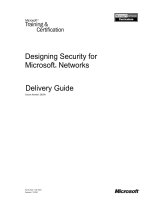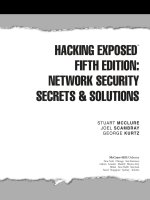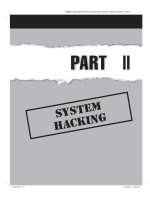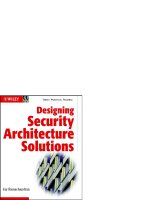designing security architecture solutions
Bạn đang xem bản rút gọn của tài liệu. Xem và tải ngay bản đầy đủ của tài liệu tại đây (1.77 MB, 483 trang )
TEAMFLY
Team-Fly
®
Designing Security
Architecture Solutions
Jay Ramachandran
John Wiley & Sons, Inc.
Wiley Computer Publishing
Designing Security
Architecture Solutions
Designing Security
Architecture Solutions
Jay Ramachandran
John Wiley & Sons, Inc.
Wiley Computer Publishing
Publisher: Robert Ipsen
Editor: Carol Long
Managing Editor: Micheline Frederick
Developmental Editor: Adaobi Obi
Text Design & Composition: D&G Limited, LLC
Designations used by companies to distinguish their products are often claimed as
trademarks. In all instances where John Wiley & Sons, Inc., is aware of a claim, the product
names appear in initial capital or
ALL CAPITAL LETTERS. Readers, however, should contact
the appropriate companies for more complete information regarding trademarks and
registration.
This book is printed on acid-free paper.
Copyright © 2002 by Jay Ramachandran. All rights reserved.
Published by John Wiley & Sons, Inc.
Published simultaneously in Canada.
No part of this publication may be reproduced, stored in a retrieval system or transmitted
in any form or by any means, electronic, mechanical, photocopying, recording, scanning
or otherwise, except as permitted under Sections 107 or 108 of the 1976 United States
Copyright Act, without either the prior written permission of the Publisher, or authoriza-
tion through payment of the appropriate per-copy fee to the Copyright Clearance Center,
222 Rosewood Drive, Danvers, MA 01923, (978) 750-8400, fax (978) 750-4744. Requests to
the Publisher for permission should be addressed to the Permissions Department, John
Wiley & Sons, Inc., 605 Third Avenue, New York, NY 10158-0012, (212) 850-6011, fax (212)
850-6008, E-Mail: PERMREQ @ WILEY.COM.
This publication is designed to provide accurate and authoritative information in regard to
the subject matter covered. It is sold with the understanding that the publisher is not
engaged in professional services. If professional advice or other expert assistance is
required, the services of a competent professional person should be sought.
Library of Congress Cataloging-in-Publication Data:
Ramachandran, Jay
Designing security architecture solutions / Jay Ramachandran.
p. cm.
“Wiley Computer Publishing.”
ISBN: 0-471-20602-4 (acid-free paper)
1. Computer security. I. Title.
QA76.9.A25 R35 2002
005.8—dc21 2001006821
Printed in the United States of America.
10987654321
For Ronak, Mallika, and Beena
DEDICATION
vii
PREFACE
Preface xvii
Acknowledgments xxvii
Part One Architecture and Security 1
Chapter 1 Architecture Reviews 3
Software Process 3
Reviews and the Software Development Cycle 4
Software Process and Architecture Models 5
Kruchten’s 4+1 View Model 6
The Reference Model for Open Distributed Processing 7
Rational’s Unified Process 9
Software Process and Security 10
Architecture Review of a System 11
The Architecture Document 12
The Introduction Section 13
Sections of the Architecture Document 15
The Architecture Review Report 19
Conclusions 19
Chapter 2 Security Assessments 21
What Is a Security Assessment? 21
The Organizational Viewpoint 22
The Five-Level Compliance Model 23
The System Viewpoint 24
Pre-Assessment Preparation 26
The Security Assessment Meeting 26
Security Assessment Balance Sheet Model 27
Describe the Application Security Process 29
Identify Assets 30
Identify Vulnerabilities and Threats 30
Identify Potential Risks 30
Examples of Threats and Countermeasures 32
Post-Assessment Activities 32
CONTENTS
Why Are Assessments So Hard? 32
Matching Cost Against Value 33
Why Assessments Are Like the Knapsack Problem 36
Why Assessments Are Not Like the Knapsack Problem 38
Enterprise Security and Low Amortized Cost Security Controls 39
Conclusion 40
Chapter 3 Security Architecture Basics 43
Security As an Architectural Goal 44
Corporate Security Policy and Architecture 45
Vendor Bashing for Fun and Profit 46
Security and Software Architecture 48
System Security Architecture Definitions 48
Security and Software Process 50
Security Design Forces against Other Goals 51
Security Principles 52
Additional Security-Related Properties 53
Other Abstract or Hard-to-Provide Properties 54
Inference 54
Aggregation 55
Least Privilege 56
Self-Promotion 56
Graceful Failure 56
Safety 57
Authentication 58
User IDs and Passwords 58
Tokens 59
Biometric Schemes 59
Authentication Infrastructures 60
Authorization 60
Models for Access Control 61
Mandatory Access Control 61
Discretionary Access Control 61
Role-Based Access Control 63
Access Control Rules 66
Understanding the Application’s Access Needs 69
Other Core Security Properties 71
Analyzing a Generic System 71
Conclusion 73
Chapter 4 Architecture Patterns in Security 75
Pattern Goals 75
Common Terminology 76
Architecture Principles and Patterns 77
The Security Pattern Catalog 78
Entity 78
Principal 78
CONTENTS
viii
TEAMFLY
Team-Fly
®
Context Holders 81
Session Objects and Cookies 81
Ticket/Token 82
Sentinel 83
Roles 83
Service Providers 84
Directory 84
Trusted Third Party 87
Validator 88
Channel Elements 89
Wrapper 89
Filter 91
Interceptor 93
Proxy 95
Platforms 96
Transport Tunnel 96
Distributor 97
Concentrator 98
Layer 98
Elevator 100
Sandbox 101
Magic 103
Conclusion 104
Part Two Low-Level Architecture 105
Chapter 5 Code Review 107
Why Code Review Is Important 107
Buffer Overflow Exploits 108
Switching Execution Contexts in UNIX 111
Building a Buffer Overflow Exploit 111
Components of a Stack Frame 112
Why Buffer Overflow Exploits Enjoy Most-Favored Status 113
Countermeasures Against Buffer Overflow Attacks 114
Avoidance 114
Prevention by Using Validators 114
Sentinel 115
Layer 115
Sandbox 116
Wrapper 116
Interceptors 118
Why Are So Many Patterns Applicable? 118
Stack Growth Redirection 119
Hardware Support 120
CONTENTS
ix
CONTENTS
x
Security and Perl 120
Syntax Validation 121
Sentinel 122
Sandbox 122
Bytecode Verification in Java 123
Good Coding Practices Lead to Secure Code 125
Conclusion 126
Chapter 6 Cryptography 129
The History of Cryptography 130
Cryptographic Toolkits 132
One-Way Functions 133
Encryption 133
Symmetric Encryption 134
Encryption Modes 135
Asymmetric Encryption 136
Number Generation 137
Cryptographic Hash Functions 138
Keyed Hash Functions 138
Authentication and Digital Certificates 139
Digital Signatures 139
Signed Messages 140
Digital Envelopes 140
Key Management 141
Cryptanalysis 142
Differential Cryptanalysis 142
Linear Cryptanalysis 142
Cryptography and Systems Architecture 143
Innovation and Acceptance 143
Cryptographic Flaws 144
Algorithmic Flaws 145
Protocol Misconstruction 145
Implementation Errors 145
Wired Equivalent Privacy 146
Performance 147
Comparing Cryptographic Protocols 148
Conclusion 149
Chapter 7 Trusted Code 151
Adding Trust Infrastructures to Systems 152
The Java Sandbox 153
Running Applets in a Browser 154
Local Infrastructure 155
Local Security Policy Definition 155
Local and Global Infrastructure 156
Security Extensions in Java 156
Systems Architecture 157
Microsoft Authenticode 157
Global Infrastructure 157
Local Infrastructure 158
Structure within the Local Machine 158
Authenticode and Safety 159
Internet Explorer Zones 159
Customizing Security within a Zone 159
Role-Based Access Control 160
Accepting Directives from Downloaded Content 160
Netscape Object Signing 162
Signed, Self-Decrypting, and Self-Extracting Packages 163
Implementing Trust within the Enterprise 163
Protecting Digital Intellectual Property 165
Thompson’s Trojan Horse Compiler 170
Some Notation for Compilers and Programs 171
Self-Reproducing Programs 171
Looking for Signatures 173
Even Further Reflections on Trusting Trust 175
An Exercise to the Reader 176
Perfect Trojan Horses 176
Conclusion 177
Chapter 8 Secure Communications 179
The OSI and TCP/IP Protocol Stacks 180
The Structure of Secure Communication 182
The Secure Sockets Layer Protocol 182
SSL Properties 183
The SSL Record Protocol 184
The SSL Handshake Protocol 184
SSL Issues 186
The IPSec Standard 187
IPSec Architecture Layers 188
IPSec Overview 189
Policy Management 190
IPSec Transport and Tunnel Modes 191
IPSec Implementation 192
Authentication Header Protocol 192
Encapsulating Security Payload 193
Internet Key Exchange 193
Some Examples of Secure IPSec Datagrams 194
IPSec Host Architecture 195
IPSec Issues 195
Conclusion 198
CONTENTS
xi
Part Three Mid-Level Architecture 199
Chapter 9 Middleware Security 201
Middleware and Security 202
Service Access 202
Service Configuration 202
Event Management 203
Distributed Data Management 204
Concurrency and Synchronization 204
Reusable Services 205
The Assumption of Infallibility 206
The Common Object Request Broker Architecture 207
The OMG CORBA Security Standard 208
The CORBA Security Service Specification 208
Packages and Modules in the Specification 209
Vendor Implementations of CORBA Security 211
CORBA Security Levels 212
Secure Interoperability 212
The Secure Inter-ORB Protocol 213
Secure Communications through SSL 214
Why Is SSL Popular? 215
Application-Unaware Security 216
Application-Aware Security 218
Application Implications 220
Conclusion 221
Chapter 10 Web Security 223
Web Security Issues 225
Questions for the Review of Web Security 226
Web Application Architecture 227
Web Application Security Options 228
Securing Web Clients 230
Active Content 230
Scripting Languages 231
Browser Plug-Ins and Helper Applications 231
Browser Configuration 231
Connection Security 232
Web Server Placement 232
Securing Web Server Hosts 233
Securing the Web Server 235
Authentication Options 235
Web Application Configuration 236
Document Access Control 237
CGI Scripts 237
JavaScript 238
Web Server Architecture Extensions 238
CONTENTS
xii
Enterprise Web Server Architectures 239
The Java 2 Enterprise Edition Standard 240
Server-Side Java 241
Java Servlets 241
Servlets and Declarative Access Control 242
Enterprise Java Beans 243
Conclusion 244
Chapter 11 Application and OS Security 247
Structure of an Operating System 249
Structure of an Application 251
Application Delivery 253
Application and Operating System Security 254
Hardware Security Issues 254
Process Security Issues 255
Software Bus Security Issues 256
Data Security Issues 256
Network Security Issues 256
Configuration Security Issues 257
Operations, Administration, and Maintenance Security Issues 258
Securing Network Services 258
UNIX Pluggable Authentication Modules 260
UNIX Access Control Lists 262
Solaris Access Control Lists 264
HP-UX Access Control Lists 267
Conclusion 268
Chapter 12 Database Security 269
Database Security Evolution 270
Multi-Level Security in Databases 270
Architectural Components and Security 273
Secure Connectivity to the Database 274
Role-Based Access Control 276
The Data Dictionary 277
Database Object Privileges 278
Issues Surrounding Role-Based Access Control 278
Database Views 279
Security Based on Object-Oriented Encapsulation 281
Procedural Extensions to SQL 282
Wrapper 283
Sentinel 284
Security through Restrictive Clauses 285
Virtual Private Database 286
Oracle Label Security 287
Read and Write Semantics 287
Conclusion 291
CONTENTS
xiii
Part Four High-Level Architecture 293
Chapter 13 Security Components 295
Secure Single Sign-On 297
Scripting Solutions 298
Strong, Shared Authentication 298
Network Authentication 299
Secure SSO Issues 299
Public-Key Infrastructures 301
Certificate Authority 303
Registration Authority 303
Repository 304
Certificate Holders 304
Certificate Verifiers 304
PKI Usage and Administration 304
PKI Operational Issues 305
Firewalls 306
Firewall Configurations 307
Firewall Limitations 307
Intrusion Detection Systems 308
LDAP and X.500 Directories 311
Lightweight Directory Access Protocol 312
Architectural Issues 313
Kerberos 314
Kerberos Components in Windows 2000 315
Distributed Computing Environment 317
The Secure Shell, or SSH 318
The Distributed Sandbox 319
Conclusion 321
Chapter 14 Security and Other Architectural Goals 323
Metrics for Non-Functional Goals 324
Force Diagrams around Security 324
Normal Architectural Design 325
Good Architectural Design 327
High Availability 328
Security Issues 331
Robustness 332
Binary Patches 333
Security Issues 334
Reconstruction of Events 335
Security Issues 335
Ease of Use 336
Security Issues 337
CONTENTS
xiv
Maintainability, Adaptability, and Evolution 338
Security Issues 339
Scalability 340
Security Issues 340
Interoperability 341
Security Issues 341
Performance 342
Security Issues 344
Portability 345
Security Issues 346
Conclusion 347
Chapter 15 Enterprise Security Architecture 349
Security as a Process 350
Applying Security Policy 351
Security Data 351
Databases of Record 352
Enterprise Security as a Data Management Problem 353
The Security Policy Repository 353
The User Repository 354
The Security Configuration Repository 354
The Application Asset Repository 355
The Threat Repository 356
The Vulnerability Repository 356
Tools for Data Management 357
Automation of Security Expertise 358
Directions for Security Data Management 359
David Isenberg and the “Stupid Network” 360
Extensible Markup Language 362
XML and Data Security 363
The XML Security Services Signaling Layer 363
XML and Security Standards 364
J2EE Servlet Security Specification 365
XML Signatures 365
XML Encryption 366
S2ML 366
SAML 367
XML Key Management Service 367
XML and Other Cryptographic Primitives 368
The Security Pattern Catalog Revisited 369
XML-Enabled Security Data 370
HGP: A Case Study in Data Management 371
Building a Single Framework for Managing Security 372
Conclusion 373
CONTENTS
xv
Part Five Business Cases and Security 375
Chapter 16 Building Business Cases for Security 377
Building Business Cases for Security 378
Financial Losses to Computer Theft and Fraud 379
Case Study: AT&T’s 1990 Service Disruption 381
Structure of the Invita Case Study 382
Security at Invita Securities Corp. 384
The Pieces of the Business Case 385
Development Costs 385
Operational Costs 387
Time-Out 1: Financial Formulas 388
Interest Rate Functions 388
Net Present Value 388
Internal Rate of Return 389
Payback Period 389
Uniform Payment 389
Break-Even Analysis 389
Breaking Even is Not Good Enough 390
Time-Out 2: Assumptions in the Saved Losses Model 390
Assumptions in the Saved Losses Model 391
Steady State Losses 391
Losses from a Catastrophic Network Disruption 392
The Agenda for the Lockup 392
Steady-State Losses 395
Catastrophic Losses 395
The Readout 396
Insuring Against Attacks 397
Business Case Conclusion 398
A Critique of the Business Case 399
Insurance and Computer Security 400
Hacker Insurance 402
Insurance Pricing Methods 403
Conclusion 404
Chapter 17 Conclusion 407
Random Advice 408
Glossary 413
Bibliography
421
Index 435
CONTENTS
xvi
xvii
PREFACE
T
here is an invisible elephant in this book: your application. And, it sits at the center of
every topic we touch in each chapter we present. This book is for systems architects
who are interested in building security into their applications. The book is designed to
be useful to architects in three ways: as an introduction to security architecture, as a
handbook on security issues for architecture review, and as a catalog of designs to look
for within a security product.
Audience
This book is meant to be a practical handbook on security architecture. It aims to pro-
vide software systems architects with a contextual framework for thinking about secu-
rity. This book is not for code writers directly, although we do talk about code when
appropriate. It is targeted toward the growing technical community of people who call
themselves systems architects. A systems architect is the technical leader on any large
project with overall responsibility for architecture, design, interface definition, and
implementation for the system. Architects play nontechnical roles, as well. They are
often involved in the planning and feasibility stages of the project, helping its owners
make a business case for the system. They must ensure that the project team follows
corporate security guidelines and the software development process all the way to
delivery. Architects have deep domain knowledge of the application, its function, and
its evolution but often are not as experienced in security architecture.
The primary audience for this book consists of project managers, systems architects,
and software engineers who need to secure their applications. It provides a conceptual
architectural framework that answers the questions, “What is systems security archi-
tecture? How should I choose from a bewildering array of security product offerings?
How should I then integrate my choices into my software? What common problems
occur during this process? How does security affect the other goals of my system archi-
tecture? How can I justify the expense of building security into my application?”
If you are currently working on a large project or you have access to the architecture
documentation of a software system you are familiar with, keep it handy and use its
architecture to give yourself a frame of reference for the discussion. A good application
can give additional depth to a particular recommendation or provide context for any
architectural issues on security or software design.
PREFACE
xviii
We assume that you have some experience with implementing security solutions and get-
ting your hands dirty. Although we introduce and present many security concepts, we
would not recommend learning about computer security from this book, because in the
interests of covering as many aspects of architecture and security as we can, we will often
cheerfully commit the sin of simplification. We will always add references to more detail
when we do simplify matters and hope this situation will not confuse the novice reader.
We hope that by the end of the book, the systems architects among you will have gained
some insights into security while the security experts wryly note our mastery of the obvi-
ous. That would mean that we have succeeded in striking the right balance!
Software Architecture
Software architecture in the past 10 years has seen growing respectability. More and
more software professionals are calling themselves software architects in recognition
that enterprise systems are increasingly complex, expensive, and distributed. Applica-
tions have raised the bar for feature requirements such as availability, scalability,
robustness, and interoperability. At the same time, as a business driver, enterprise secu-
rity is front and center in the minds of many managers. There is a tremendously diverse
community of security professionals providing valuable but complicated services to
these enterprise architects. Architects have clear mandates to implement corporate
security policy, and many certainly feel a need for guidelines on how to do so. We wrote
this book to provide architects with a better understanding of security.
Software development converts requirements into systems, products, and services.
Software architecture has emerged as an important organizing principle, providing a
framework upon which we hang the mass of the application. Companies are recogniz-
ing the value of enterprise architecture guidelines, along with support for process defi-
nition, certification of architects, and training. Software architecture promises cost
savings by improving release cycle time, reducing software defects, enabling reuse of
architecture and design ideas, and improving technical communication.
There are many excellent books on security and on software architecture. There is also
a vast and mature collection of academic literature in both areas, many listed in our bib-
liography. This book targets readers in the intersection of the two fields.
When we use the term
system or application in this book, we mean a collection of
hardware and software components on a platform to support a business function with
boundaries that demark the inside and outside of the system, along with definitions of
interfaces to other systems. Systems have business roles in the company. They belong
to business processes and have labels: customer Web application, benefits directory,
employee payroll database, customer order provisioning, billing, network management,
fulfillment, library document server, and so on.
Security can be approached from perspectives other than the viewpoint of securing a
system. A project might be developing a shrink-wrapped product, such as a computer
TEAMFLY
Team-Fly
®
game or a PC application; or might be providing a distributed service, such as an e-mail
or naming server; or be working on an infrastructure component, such as a corporate
directory. Security goals change with each change in perspective. Our presentation of
security principles in this book is general enough to apply to these other viewpoints,
which also can benefit from secure design.
Project Objectives versus Security
Experience
Companies wish to include security policy into architecture guidelines but run into dif-
ficulties trying to chart a path on implementation decisions. Unless we realize that the
problem does not lie with our talented and competent development teams but instead
lies in their lack of background information about security, we will run into significant
resistance project after project
—
repeatedly going over the same security issues at the
architecture review. We must be able to present security issues in an architectural con-
text to guide the project.
As system architects, we would like to believe that all our decisions are driven by tech-
nical considerations and business goals. We would like to believe that every time our
project team meets to make a decision, we would be consistent
—
arriving at the same
decision no matter who took the day off. Human nature and personal experience
inform our decisions as well, however. On a system that is under construction within
the confines of budget and time, the strengths of the lead architects and developers can
strongly warp the direction and priority of functional and non-functional goals.
An object-oriented methodology guru might spend a fair amount of resources develop-
ing the data model and class diagrams. A programmer with a lot of experience building
concurrent code might introduce multi-threading everywhere, creating producers and
consumers that juggle mutexes, locks, and condition variables in the design. A database
designer with experience in one product might bring preconceived notions of how
things should be to the project that uses another database. A CORBA expert might engi-
neer interface definitions or services with all kinds of detail to anticipate evolution, just
because he knows how. A Web designer on the front-end team might go crazy with the
eye candy of the day on the user interface. None of these actions are inherently bad,
and much of it is very valuable and clearly useful. At the end, however, if the project
does not deliver what the customer wants with adequate performance and reliability,
we have failed.
What if no one on your team has much experience with security? In a conflict between
an area where we are somewhat lost and another where we can accomplish a signifi-
cant amount of productive work, we pick the task where we will make the most
progress. The problem arises with other facets of systems architecture as well, which
might fall by the wayside because of a lack of experience or a lack of priority. Project
teams declare that they cannot be highly available, cannot do thorough testing, or can-
not do performance modeling because they do not have the time or the money to do so.
This situation might often be the case, but if no one on the team has expertise building
PREFACE
xix
reliable systems or regression testing suites or queuing theoretic models of service,
then human nature might drive behavior away from these tasks.
Security architecture often suffers from this syndrome. Fortunately, we have a solution
to our knowledge gap: Buy security and hire experts to secure our system. This point is
where vendors come in to help us integrate their solutions into our applications.
Vendor Security Products
The Internet boom has also driven the growth of security standards and technologies.
Software vendors provide feature-rich security solutions and components at a level of
complexity and maturity beyond almost all projects. Building our own components is
rarely an option, and security architecture work is primarily integration work. In
today’s environment, the emerging dominance of vendor products aiding software
development for enterprise security cannot be ignored.
We interact with vendors on many levels, and our understanding of their product offer-
ings depends on a combination of information from many sources: marketing, sales,
customer service support, vendor architects, and other applications with experience
with the product. We have to be careful when viewing the entire application from the
perspective of the security vendor. Looking at the application through a fisheye lens to
get a wide-angle view could give us a warped perspective, with all of the elements of the
system distorted around one central component: their security product. Here are three
architectural flaws in vendor products:
The product enjoys a central place in the architecture. The product places itself
at the center of the universe, which might not be where you, as the architect, would
place it.
The product hides assumptions. The product hides assumptions that are critical to
a successful deployment or does not articulate these assumptions as clear
architectural prerequisites and requirements to the project.
The context behind the product is unclear. Context describes the design philosophy
behind the purpose and placement of the product in some market niche. What is the
history of the company with respect to building this particular security product?
The vendor might be the originator of the technology, might have diversified into the
product space, acquired a smaller company with expertise in the security area, or
might have a strong background in a particular competing design philosophy.
Vendors have advantages over architects.
■■
They tend to have comparatively greater security expertise.
■■
They often do not tell architects about gaps in their own product’s design
voluntarily. You have to ask specific questions about product features.
■■
They rarely present their products in terms clearly comparable with those of their
competitors. Project teams have to expend effort in understanding the feature sets
well enough to do so themselves.
PREFACE
xx
■■
They deflect valid criticism of holes in their design by assigning resolution
responsibility to the user, administrator, application process, or other side of an
interface, and so on.
■■
They rarely support the evolution path of an application over a two- to three-year
timeframe.
This book is meant to swing the advantage back in the architect’s court. We will describe
how projects can evaluate vendor products, discover limitations and boundaries within
solutions, and overcome them. Vendors are not antagonistic to the project’s objectives,
but miscommunication during vendor management might cause considerable friction as
the application evolves and we learn more about real-world deployment issues surround-
ing the product. Building a good relationship between application architect and lead ven-
dor engineers is critical and holds long-run benefits for the project and vendor alike. We
hope that better information will lead to better decisions on security architecture.
Our Goals in Writing This Book
On a first level, we will present an overview of the software process behind systems
architecture. We focus on the architecture review, a checkpoint within the software
development cycle that gives the project an opportunity to validate the solution archi-
tecture and verify that it meets requirements. We will describe how to assess a system
for security issues, how to organize the architecture to add security as a system feature,
and how to provide architectural context information that will help minimize the
impact of implementing one security choice over another. We emphasize including
security early in the design cycle instead of waiting until the application is in produc-
tion and adding security as an afterthought.
On a second level, this book will provide hands-on help in understanding common, repeat-
ing patterns of design in the vast array of security products available. This book will help
describe the vocabulary used surrounding security products as applied to systems architec-
ture. We borrow the term
patterns from the Object Patterns design community but do not
intend to use the term beyond its common-sense meaning. Specifically, something is a secu-
rity pattern if we can give it a name, observe its design appearing repeatedly in many secu-
rity products, and see some benefit in defining and describing the pattern.
On a third level, we describe common security architecture issues and talk about secu-
rity issues for specific technologies. We use three layers of application granularity to
examine security.
■■
Low-level issues regarding code review, cryptographic primitives, and trusting
code.
■■
Mid-level issues regarding middleware or Web services, operating systems, hosts,
and databases.
■■
High-level issues regarding security components, conflicts between security and
other system goals, and enterprise security.
PREFACE
xxi
On the fourth and final level, we discuss security from a financial standpoint. How can
we justify the expense of securing our application?
Reading This Book
We have organized the book into five parts, and aside from the chapters in Part I, any
chapter can be read on its own. We would recommend that readers with specific inter-
ests and skills try the following tracks, however:
Project and software process managers. Begin by reading Chapters 1, 2, 3, 4, and
15. These chapters present vocabulary and basic concerns surrounding security
architecture.
Security assessors. Begin by reading Chapters 1, 2, 3, 4, 13, and 14. Much of the
information needed to sit in a review and understand the presentation is described
there.
Developers. Read Chapters 1 through 4 in order and then Chapters 5 through 12 in
any order
—
looking for the particular platform or software component that you are
responsible for developing.
Systems architects. Read the book from start to finish, one complete part at a time.
The presentation order, from Process to Technology to Enterprise concerns,
parallels the requirements of systems architecture for a large application. All of
these topics are now considered part of the domain of software architects.
Business executives. Read Chapters 1, 2, 16, and 17 for a start and then continue as
your interests guide you with anything in between.
Outline of the Book
Each chapter is a mix of the abstract and the concrete. For more detail on any technical
matter, please see the list of bibliographic references at the end of the book. Each chap-
ter will also contain questions to ask at an architecture review on a specific subject.
Part I, Architecture and Security, introduces the business processes of architecture
review and security assessments. We describe the basics of security architecture and a
catalog of security patterns.
Chapter 1, “Architecture Reviews,” describes a key checkpoint in the software
development cycle where architects can ask and answer the question, “Does the
solution fit the problem?” We present a description of the review process along with
its benefits.
Chapter 2, “Security Assessments,” defines the process of security assessment by
using the Federal Information Technology Security Assessment Framework along
with other industry standards. We describe how assessments realize many of the
benefits of architecture reviews within the specific context of security.
PREFACE
xxii









